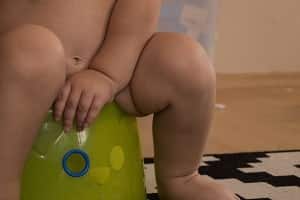Potty training is a huge undertaking that can seem overwhelming to parents at first, but it’s not all bad! In fact, there are lots of ways to potty train babies and since we’re about to tackle this milestone head-on with my son, I thought it would be a good idea to check out all of the different methods beforehand. Today, we’re looking at child-oriented potty training!
First introduced by Dr. T. Berry Brazelton in 1962, child-oriented potty training focuses on letting the child decide when they are ready to potty train and how quickly they progress. As the child goes through the system, parents continually watch for signs that they are comfortable and ready to move on to the next step.
My wife and I generally avoid trying to force certain things onto our children before they are ready. Every baby is different and they will learn and progress in different ways as they grow up. That doesn’t mean, however, that we don’t encourage them towards different milestones such as crawling or walking, but we definitely don’t obsess over it. When it comes to potty training, we’ll probably be no different so we like the idea of our son leading the way as much as possible. That being said, we don’t want potty training to take a year!
Table of Contents
What is child-oriented potty training?
Dr. Brazelton was a pediatrician back in the 1960s and he began noticing an increase in potty training issues over time that included toilet refusal, severe constipation, and outright failure. As it turns out, forcing children into potty training too early has been shown to cause significant bladder issues that lead to chronic pee holding and daytime wetting. It can also cause unnecessary stress and anxiety for both the child and parents.
At that time, parents were generally trying to get their children to potty train as early as possible. This meant many babies were less than two years old when they started getting pressured into controlling their bladders and bowel movements and typically they weren’t physically or mentally ready to get started yet. His response was to let children help decide when they would start potty training by showing classic signs and how quickly they would progress.
In a landmark study, he looked at 1,170 children over 10 years at his practice to see what the results would be if he waited for the child to show interest and displayed physiological and psychological readiness. The results were that over 80 percent of the children completed daytime training between 2 and 2.5 years of age and nighttime training by the age of three. Only 1.4% were considered failures with this system after five years.
Encouraged by these results, he created a system that he could share with other parents once they saw the signs.
The classic signs that your child is ready to potty train
Even though babies don’t have a guidebook about what they should be doing and when they should do it, they will pick up on the behavior of mommy and daddy. Their own body is also constantly growing and changing, allowing them to pick up new skills as they develop. With potty training, there are some pretty clear signs that most babies will start to show you when they are getting ready to start.
Ask yourself the following questions:
- Is your child interested in the toilet and using it?
- Is your child able to climb up to and sit on a regular toilet or use a toilet trainer?
- Does your child stay dry for a couple of hours at a time on their own?
- Do they wake up with a dry diaper in the morning?
- Can your toddler tell you when she needs to pee or poop?
- Can your child follow instructions and respond to what you say?
- Is your child at least 18 months old?
- Is your baby taking off her diaper or putting her hands in it after peeing?
If you were able to answer most of these questions positively, then you are probably ready to start toilet training!
How to use child-oriented potty training
Once you have decided to start, you’ll need to get your game plan in order based on the following steps. You will also need to pick up a potty chair beforehand that you will use to make things easier for your child. I highly recommend getting this one on Amazon because it looks just like mom and dad’s potty, makes a fun noise when the child flushes, and even included a handy wipe holder to encourage good habits! It’s so cute!
Here are the steps for child-oriented potty training:
- Introduce your child to the potty chair and make sure they understand it is their own special chair to use while potty training. Let them get comfortable with it, but be sure there is a connection to the real toilet. I recommend leaving the potty chair in the bathroom and if you get the one I recommended it will look just like yours!
- Each day, ask your child to sit on the chair (clothes and all) while you use the toilet. You can read to them or give them a small treat to keep them on the chair for a little while, but let him leave when he wants to.
- After a couple of weeks, start removing your child’s diaper before he sits on the potty. Don’t make any demands or have any expectations at this point.
- After another week or so, start taking your child to his potty chair and show him as you empty the diaper into the potty. Explain that this is where poop goes!
- If your child seems to be understanding, keep this routine up for a while.
- Over time, your child will probably get interested in using the potty all by himself so you can start removing his diaper for an hour or so each day. Keep the potty nearby and encourage him to use it if needed. Don’t be afraid to gently remind him that he isn’t wearing a diaper!
- If things are going well, you can consider using disposable or cloth training pants so that they can (hopefully) take their diaper off at the potty chair when they need to go – just like mommy and daddy!
- Boys will need one extra step. Once he has the control figured out, dads can start teaching them to stand and pee with a demonstration. Warning: This can get messy!
Ideally, your daytime training will transfer over to nighttime, but this won’t always be the case. If your child is still struggling at night, keep them in a diaper and focus on daytime consistency for a while before worrying about overnight!
Don’t forget the praise
A big part of Dr. Brazelton’s approach is that children should be praised throughout the process to help encourage them towards success. Avoid any comments that could make your child feel ashamed and don’t punish him if he isn’t going a good job yet. Every child will take a different path and pace towards becoming potty trained!
When praising, you want to thank your child for following instructions and communicating with you to help solidify your cooperation in the future. You’ll also want to give special attention to encouraging his autonomy since he is beginning to do things without the direct help of mommy and daddy. Make sure he sees that you are impressed with his progress!
Step back or pause if your toddler has potty training resistance
You can see from the steps that this system is meant to be pretty laid-back and there aren’t really any deadlines where progress is concerned. This lack of urgency is intentional because we want to see how quickly our child is progressing and how interested he is in moving on to the next step before we transition.
If your child runs into a step that she isn’t comfortable with or seems to have stopped progressing through the system – don’t force her! At that point, pause the training at the step you are on and keep up the routine until she becomes interested in moving on again. Because of this emphasis, you may find yourself moving through some steps more quickly than suggested while others end up taking way longer.
Throughout the whole child-oriented potty training process, it’s important that parents avoid getting frustrated because of a lack of results. As long as your baby is interested in the process, everything is okay.
Pros of child-oriented potty training
- A lack of structure or deadlines means the whole process is more laid-back
- Your child will be less stressed throughout the process
- Children can have more fun during the process and enjoy the praise
- A high overall success rate over time
- Great for children with a stay-at-home parent
Cons of child-oriented potty training
- A lack of structure or deadlines means the process can take a long time – even up to a year
- Parents could get frustrated with the lack of progress
- Requires a lot of day-to-day supervision and routine
- The system could be difficult to use for children in daycare
What about delayed toilet training?
If you are currently potty training your little one or you are otherwise concerned that your toddler is too old to not be potty trained yet – don’t worry!
As it turns out, a kid isn’t technically delayed unless they are over the age of three and haven’t been able to become potty trained after three months of trying. Some other experts even say you shouldn’t be worried until the age of four. This is also assuming that there aren’t any other physical or mental issues that could be holding them back.
Either way, it’s okay to take your time.
By not rushing your child into the complex physical, mental, and emotional of potty training until they are ready, you’ll be helping everyone out in the long run!










